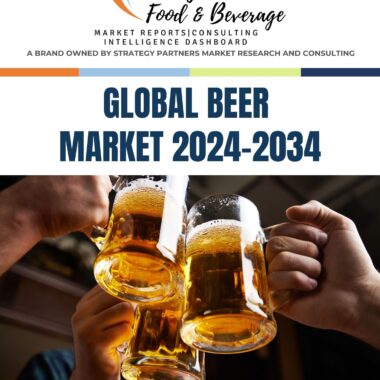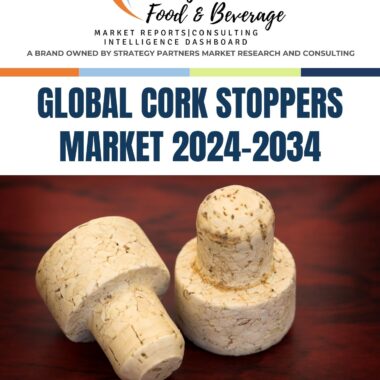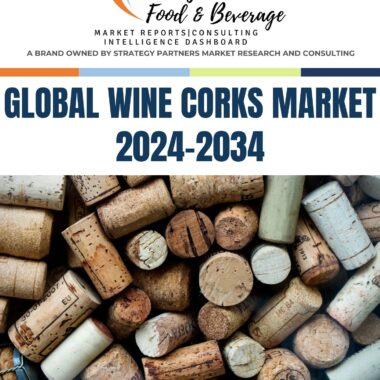Description
Gluten is a protein found in wheat, rye, and barley. People with celiac disease, gluten intolerance, and wheat allergies cannot consume gluten without experiencing adverse health effects. Gluten-free beer is beer that is made without gluten-containing ingredients.
The key trends driving the growth of the global gluten-free beer market include:
Increasing prevalence of celiac disease and gluten intolerance: The prevalence of celiac disease and gluten intolerance is increasing worldwide. This is due to a number of factors, including genetic predisposition, environmental factors, and dietary changes.
Growing awareness of the benefits of gluten-free diets: There is growing awareness of the benefits of gluten-free diets, both for people with celiac disease and gluten intolerance, and for people who do not have these conditions. Gluten-free diets have been linked to a number of health benefits, including reduced inflammation, improved gut health, and weight loss.
Rising disposable incomes in developing countries: The rising disposable incomes in developing countries are leading to increased demand for gluten-free beer. Consumers in developing countries are increasingly demanding healthy and nutritious food and beverage products, including gluten-free beer.
The key product segments in the global gluten-free beer market include:
Lager: Lager is the largest product segment in the global gluten-free beer market. Lager is a type of beer that is brewed at a low temperature and fermented for a long period of time. Lager is typically light in color and has a crisp, clean flavor.
Ale: Ale is the second largest product segment in the global gluten-free beer market. Ale is a type of beer that is brewed at a high temperature and fermented for a short period of time. Ale is typically dark in color and has a full-bodied flavor.
Other gluten-free beer products: Other gluten-free beer products include wheat beer, stout, and sour beer.
The key distribution channels in the global gluten-free beer market include:
Supermarkets and hypermarkets: Supermarkets and hypermarkets are the largest distribution channel for gluten-free beer. Supermarkets and hypermarkets offer a wide variety of gluten-free beer products from a variety of brands.
Convenience stores: Convenience stores are another important distribution channel for gluten-free beer. Convenience stores offer a limited selection of gluten-free beer products, but they are convenient for consumers who are looking for a quick and easy drink.
Online retailers: Online retailers are also becoming an important distribution channel for gluten-free beer. Online retailers offer a wide variety of gluten-free beer products from a variety of brands.
The key challenges facing the global gluten-free beer market include:
High cost of gluten-free beer: Gluten-free beer is typically more expensive than regular beer. This is due to the higher cost of gluten-free ingredients and the more complex brewing process required to make gluten-free beer.
Limited availability of gluten-free beer: Gluten-free beer is not always widely available. This is due to the fact that gluten-free beer is a relatively new product and that there is a limited supply of gluten-free ingredients.
Lack of awareness of gluten-free beer: Some consumers are not aware of gluten-free beer or the benefits it offers. This can make it difficult for manufacturers of gluten-free beer to market their products to consumers.
Despite the challenges, the global gluten-free beer market is expected to continue to grow in the coming years. This is due to the increasing demand for gluten-free beer among people with celiac disease, gluten intolerance, and wheat allergies.
Here are some additional thoughts on the global gluten-free beer market:
The market for organic and natural gluten-free beer is growing rapidly. This is due to the increasing demand for organic and natural food and beverage products.
The market for gluten-free beer in developing countries is expected to grow significantly in the coming years. This is due to the rising disposable incomes and the growing awareness of the benefits of gluten-free diets in developing countries.
Manufacturers of gluten-free beer are focusing on developing new and innovative products to meet the changing needs of consumers. For example, some manufacturers are developing gluten-free beer products that are flavored with exotic fruits and spices.
The growing popularity of plant-based diets is driving the demand for vegan gluten-free beer products. Vegan gluten-free beer products are made with plant-based ingredients and do not contain animal products
Table of Content
1 Market Introduction- Global Gluten-Free Beer Market
1.1 Market Segmentation- Global Gluten-Free Beer Market
1.2 Key Trends- Global Gluten-Free Beer Market
1.2.1 Drivers
1.2.2 Restraints
1.2.3 Challenges
2 Global Market Forecast- Global Gluten-Free Beer Market
2.1.1 By Region
2.1.2 By Ingredient Type
2.1.3 By Type
2.1.4 By Distribution Channel
3 Country Wise Forecast- Global Gluten-Free Beer Market
3.1 US
3.1.1 Key Trends
3.1.2 Consumer Spending
o Population
o GDP
o CPI
o Spend per Capita
o Spend as a proportion of GDP
3.1.3 Market Forecast- US Gluten-Free Beer Market
o By Ingredient Type
o By Type
o By Distribution Channel
3.1.4 Key Competitors- US Gluten-Free Beer Market
3.1.5 EXIM
3.1.6 Patents
3.1.7 Scenario Analysis- US Gluten-Free Beer Market
3.1.8 Opportunity Analysis- US Gluten-Free Beer Market
3.2 Canada
3.2.1 Key Trends
3.2.2 Consumer Spending
o Population
o GDP
o CPI
o Spend per Capita
o Spend as a proportion of GDP
3.2.3 Market Forecast- Canada Gluten-Free Beer Market
o By Ingredient Type
o By Type
o By Distribution Channel
3.2.4 Key Competitors
3.2.5 EXIM
3.2.6 Patents
3.2.7 Scenario Analysis
3.2.8 Opportunity Analysis
3.3 UK
3.3.1 Key Trends
3.3.2 Consumer Spending
o Population
o GDP
o CPI
o Spend per Capita
o Spend as a proportion of GDP
3.3.3 Market Forecast
o By Ingredient Type
o By Type
o By Distribution Channel
3.3.4 Key Competitors
3.3.5 EXIM
3.3.6 Patents
3.3.7 Scenario Analysis
3.3.8 Opportunity Analysis
3.4 Germany
3.4.1 Key Trends
3.4.2 Consumer Spending
o Population
o GDP
o CPI
o Spend per Capita
o Spend as a proportion of GDP
3.4.3 Market Forecast
o By Ingredient Type
o By Type
o By Distribution Channel
3.4.4 Key Competitors
3.4.5 EXIM
3.4.6 Patents
3.4.7 Scenario Analysis
3.4.8 Opportunity Analysis
3.5 France
3.5.1 Key Trends
3.5.2 Consumer Spending
o Population
o GDP
o CPI
o Spend per Capita
o Spend as a proportion of GDP
3.5.3 Market Forecast
o By Ingredient Type
o By Type
o By Distribution Channel
3.5.4 Key Competitors
3.5.5 EXIM
3.5.6 Patents
3.5.7 Scenario Analysis
3.5.8 Opportunity Analysis
3.6 Italy
3.6.1 Key Trends
3.6.2 Consumer Spending
o Population
o GDP
o CPI
o Spend per Capita
o Spend as a proportion of GDP
3.6.3 Market Forecast
o By Ingredient Type
o By Type
o By Distribution Channel
3.6.4 Key Competitors
3.6.5 EXIM
3.6.6 Patents
3.6.7 Scenario Analysis
3.6.8 Opportunity Analysis
3.7 Ireland
3.7.1 Key Trends
3.7.2 Consumer Spending
o Population
o GDP
o CPI
o Spend per Capita
o Spend as a proportion of GDP
3.7.3 Market Forecast
o By Ingredient Type
o By Type
o By Distribution Channel
3.7.4 Key Competitors
3.7.5 EXIM
3.7.6 Patents
3.7.7 Scenario Analysis
3.7.8 Opportunity Analysis
3.8 Spain
3.8.1 Key Trends
3.8.2 Consumer Spending
o Population
o GDP
o CPI
o Spend per Capita
o Spend as a proportion of GDP
3.8.3 Market Forecast
o By Ingredient Type
o By Type
o By Distribution Channel
3.8.4 Key Competitors
3.8.5 EXIM
3.8.6 Patents
3.8.7 Scenario Analysis
3.8.8 Opportunity Analysis
3.9 Belgium
3.9.1 Key Trends
3.9.2 Consumer Spending
o Population
o GDP
o CPI
o Spend per Capita
o Spend as a proportion of GDP
3.9.3 Market Forecast
o By Ingredient Type
o By Type
o By Distribution Channel
3.9.4 Key Competitors
3.9.5 EXIM
3.9.6 Patents
3.9.7 Scenario Analysis
3.9.8 Opportunity Analysis
3.10 Switzerland
3.10.1 Key Trends
3.10.2 Consumer Spending
o Population
o GDP
o CPI
o Spend per Capita
o Spend as a proportion of GDP
3.10.3 Market Forecast
o By Ingredient Type
o By Type
o By Distribution Channel
3.10.4 Key Competitors
3.10.5 EXIM
3.10.6 Patents
3.10.7 Scenario Analysis
3.10.8 Opportunity Analysis
3.11 Sweden
3.11.1 Key Trends
3.11.2 Consumer Spending
o Population
o GDP
o CPI
o Spend per Capita
o Spend as a proportion of GDP
3.11.3 Market Forecast
o By Ingredient Type
o By Type
o By Distribution Channel
3.11.4 Key Competitors
3.11.5 EXIM
3.11.6 Patents
3.11.7 Scenario Analysis
3.11.8 Opportunity Analysis
3.12 Portugal
3.12.1 Key Trends
3.12.2 Consumer Spending
o Population
o GDP
o CPI
o Spend per Capita
o Spend as a proportion of GDP
3.12.3 Market Forecast
o By Ingredient Type
o By Type
o By Distribution Channel
3.12.4 Key Competitors
3.12.5 EXIM
3.12.6 Patents
3.12.7 Scenario Analysis
3.12.8 Opportunity Analysis
3.13 The Netherlands
3.13.1 Key Trends
3.13.2 Consumer Spending
o Population
o GDP
o CPI
o Spend per Capita
o Spend as a proportion of GDP
3.13.3 Market Forecast
o By Ingredient Type
o By Type
o By Distribution Channel
3.13.4 Key Competitors
3.13.5 EXIM
3.13.6 Patents
3.13.7 Scenario Analysis
3.13.8 Opportunity Analysis
3.14 Brazil
3.14.1 Key Trends
3.14.2 Consumer Spending
o Population
o GDP
o CPI
o Spend per Capita
o Spend as a proportion of GDP
3.14.3 Market Forecast
o By Ingredient Type
o By Type
o By Distribution Channel
3.14.4 Key Competitors
3.14.5 EXIM
3.14.6 Patents
3.14.7 Scenario Analysis
3.14.8 Opportunity Analysis
3.15 Mexico
3.15.1 Key Trends
3.15.2 Consumer Spending
o Population
o GDP
o CPI
o Spend per Capita
o Spend as a proportion of GDP
3.15.3 Market Forecast
o By Ingredient Type
o By Type
o By Distribution Channel
3.15.4 Key Competitors
3.15.5 EXIM
3.15.6 Patents
3.15.7 Scenario Analysis
3.15.8 Opportunity Analysis
3.16 Australia
3.16.1 Key Trends
3.16.2 Consumer Spending
o Population
o GDP
o CPI
o Spend per Capita
o Spend as a proportion of GDP
3.16.3 Market Forecast
o By Ingredient Type
o By Type
o By Distribution Channel
3.16.4 Key Competitors
3.16.5 EXIM
3.16.6 Patents
3.16.7 Scenario Analysis
3.16.8 Opportunity Analysis
3.17 China
3.17.1 Key Trends
3.17.2 Consumer Spending
o Population
o GDP
o CPI
o Spend per Capita
o Spend as a proportion of GDP
3.17.3 Market Forecast
o By Ingredient Type
o By Type
o By Distribution Channel
3.17.4 Key Competitors
3.17.5 EXIM
3.17.6 Patents
3.17.7 Scenario Analysis
3.17.8 Opportunity Analysis
3.18 Indonesia
3.18.1 Key Trends
3.18.2 Consumer Spending
o Population
o GDP
o CPI
o Spend per Capita
o Spend as a proportion of GDP
3.18.3 Market Forecast
o By Ingredient Type
o By Type
o By Distribution Channel
3.18.4 Key Competitors
3.18.5 EXIM
3.18.6 Patents
3.18.7 Scenario Analysis
3.18.8 Opportunity Analysis
3.19 India
3.19.1 Key Trends
3.19.2 Consumer Spending
o Population
o GDP
o CPI
o Spend per Capita
o Spend as a proportion of GDP
3.19.3 Market Forecast
o By Ingredient Type
o By Type
o By Distribution Channel
3.19.4 Key Competitors
3.19.5 EXIM
3.19.6 Patents
3.19.7 Scenario Analysis
3.19.8 Opportunity Analysis
3.20 Japan
3.20.1 Key Trends
3.20.2 Consumer Spending
o Population
o GDP
o CPI
o Spend per Capita
o Spend as a proportion of GDP
3.20.3 Market Forecast
o By Ingredient Type
o By Type
o By Distribution Channel
3.20.4 Key Competitors
3.20.5 EXIM
3.20.6 Patents
3.20.7 Scenario Analysis
3.20.8 Opportunity Analysis
3.21 South Korea
3.21.1 Key Trends
3.21.2 Consumer Spending
o Population
o GDP
o CPI
o Spend per Capita
o Spend as a proportion of GDP
3.21.3 Market Forecast
o By Ingredient Type
o By Type
o By Distribution Channel
3.21.4 Key Competitors
3.21.5 EXIM
3.21.6 Patents
3.21.7 Scenario Analysis
3.21.8 Opportunity Analysis
3.22 Thailand
3.22.1 Key Trends
3.22.2 Consumer Spending
o Population
o GDP
o CPI
o Spend per Capita
o Spend as a proportion of GDP
3.22.3 Market Forecast
o By Ingredient Type
o By Type
o By Distribution Channel
3.22.4 Key Competitors
3.22.5 EXIM
3.22.6 Patents
3.22.7 Scenario Analysis
3.22.8 Opportunity Analysis
3.23 Malaysia
3.23.1 Key Trends
3.23.2 Consumer Spending
o Population
o GDP
o CPI
o Spend per Capita
o Spend as a proportion of GDP
3.23.3 Market Forecast
o By Ingredient Type
o By Type
o By Distribution Channel
3.23.4 Key Competitors
3.23.5 EXIM
3.23.6 Patents
3.23.7 Scenario Analysis
3.23.8 Opportunity Analysis
3.24 Singapore
3.24.1 Key Trends
3.24.2 Consumer Spending
o Population
o GDP
o CPI
o Spend per Capita
o Spend as a proportion of GDP
3.24.3 Market Forecast
o By Ingredient Type
o By Type
o By Distribution Channel
3.24.4 Key Competitors
3.24.5 EXIM
3.24.6 Patents
3.24.7 Scenario Analysis
3.24.8 Opportunity Analysis
4 Opportunity Matrix- Global Gluten-Free Beer Market
5 Conclusions and Recommendations- Global Gluten-Free Beer Market
6 About Global Food & Beverage




